|
Food
and drink biodiversity:
Fruit
Berries
|
Fragaria
species (Strawberry)
Family: Rosaceae Strawberry fruit are eaten raw or used in making juice, desserts, jam,
syrup and wine. Fruit, leaves and roots are also used medicinally. The
Modern Garden Strawberry Fragaria ananassa, which is the main
species grown these days, arose in the gardens of Europe as a hybrid
between two New World species that had been introduced to Europe by the
Spanish colonists.
|
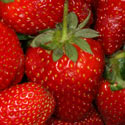 |
|
Rubus
species (Bramble,
Blackberry, Loganberry, Youngberry and Raspberry)
Family: Rosaceae Since earliest times, people have collected berries
from species of Rubus. They are eaten raw, cooked, or made into
other products such as jam and juice. Berries have high levels of vitamins
A, B1 and C. Dry leaves are used in herbal teas and both leaves and roots
are used medicinally.
|
|
|
Vaccinium
species (Cranberry and blueberry)
Family: Ericaceae Cranberries and blueberries originate from North
America where there are a large number of different Vaccinium
species that are referred to by one of these names. Commercial planting
still often involves using wild stock, but in addition hybrid cultivars
have been developed.
|
|
Melons
|
Citrullus lanatus
(Watermelon)
Family: Cucurbitaceae
The Watermelon is thought to have been domesticated
in Africa at least 4000 years ago and is now grown worldwide, particularly in
regions with long, hot summers.
|
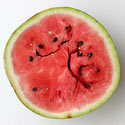 |
|
Cucumis melo
(Muskmelon, including winter melon and spanspek)
Family: Cucurbitaceae
The wild Muskmelon has an indigenous distribution over the desert and
savanna regions of Africa, Arabia, southwestern Asia and Australia,
including in southern Africa, and was domesticated in Africa and
southwestern Asia more than 4000 years ago. It now comes in a range of forms
including those with netted rinds (e.g. spanspek / cantaloup) and those with
smooth rinds (e.g. wintermelon). Melons are usually eaten fresh as an hors
d'oeuvre at the beginning of the meal or as a dessert fruit at the end
of the meal.
|
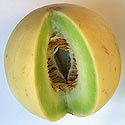
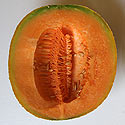 |
|
Cucumis metuliferus (Jelly
melon, African horned cucumber, Kiwano) Native to
African woodlands and grasslands, prefering those regions with a hot
climate. Within southern Africa, it occurs in Namibia, Botswana, Swaziland
and South Africa (Limpopo, Mpumalanga and KwaZulu-Natal). It has become a
weed in Queensland, Australia. The fruit is distinctive in having short
horn-like processes widely spaced over its surface. It turns orange when
ripe. Non-bitter varieties are commercially cultivated in South Africa and
New Zealand. In the latter country it has been named and trademarked
as 'kiwano', in a similar manner to
Kiwifruit.
|
|
CitrusThe genus Citrus is native to southeast Asia,
occurring from northern India to China and south through Malaysia, the East
Indies and the Philippines. The history of domestication has been hard to
establish because archaeological evidence is lacking and it has been difficult
to link names and descriptions in ancient accounts with the actual species we
know today. Records of domestication go back to about 500 BC.
Citrus fruits are high in vitamin C, flavonoids,
acids and volatile oils. They contain coumarins such as bergapten which make the
skin sensitive to sunlight. Many citrus species and varieties are not cultivated
for producing fresh edible fruit but are sour and used for other purposes. From
a cullinary point of view, leaves are used for flavouring foods and the skin of
fruit is used for making marmalade. Citrus is also used extensively for
medicinal and toiletry products.
|
Citrus aurantium (Seville, Bergamot or Sour
Orange)
Family:
Rutaceae
Hybrid between Pummelo
Citrus grandis and
Mandarin Citrus reticulata.
Citrus
aurantium orginated in China and seems to have entered the written
record there by 300 BC. Because of its sour and bitter taste, Sour orange is not usually eaten raw but used for:
(1) making marmalade and candied peel; (2) producing essential oils for use in
soaps and perfume; (3) scenting tea using the flower buds; and (4) fruit
extracts are used to flavour soft drinks and the aromatic oil is used in
distilling certain liqueurs. Bergamot yields
oil from the flowers which is used in perfumery (e.g. in Eau de Cologne),
and which is the substance added to Earl Grey tea to give it that
distinctive flavour. |
|
|
Citrus limon (Lemon)
Family:
Rutaceae
Hybrid between Citron
Citrus medica and Lime
Citrus aurantifolia.
The place and date of origin of the Lemon is uncertain but it probably
came from China. Lemon is used for making lemonade, it is used in
drinks, and for flavouring a wide variety of foods. The essential oil
from Lemon is known as cedro oil, and is used as a flavouring in the
food industry and is also used in soaps, detergents and perfumes. |
|
Citrus paradisii (Grapefruit)
Family:
Rutaceae Hybrid between Pummelo
Citrus maxima and Sweet Orange
Citrus
sinensis.
This hybrid species is thought to have originated on the island of
Barbados in about 1750. Further varieties of Grapefruit were developed
mainly in Florida and Texas, USA. Grapefruit are usually eaten by
cutting them in half and scooping out the flesh, often with a little
sugar added to relieve the bitterness. They are also used in juices and
fruit salads. |
|
|
Citrus reticulata (Mandarin, Satsuma and Tangerine,
Naartjie)
Family:
Rutaceae
The Mandarin was probably domesticated in tropical Southeast Asia. By 500
BC it was known in China and by 300 BC it was being grown commercially
in central China. By 400 AD, grafting methods were being used to clone
favourable varieties. It was introduced to Japan at
an early stage, and it was here that the Satsuma variety was developed. Despite
its popularity in Asia, it was only in the 1800's that Citrus
reticulata was established in Europe, North Africa, West Indies, North
and South America, and Australia. |
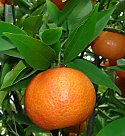 |
|
Citrus sinensis (Edible, Sweet, Valencia,
Navel Orange)
Family:
Rutaceae
Hybrid between Pummelo
Citrus maxima and Mandarin
Citrus
reticulata. Although originating from the same
parent species as Citrus aurantium, the actual parents were different
varieties to those of Citrus aurantium. There are clear records of
Citrus sinensis in China only by the 1100's and in India by the 1300's.
By the 1400's it had spread to the Mediterranean. From the mid 1600's
onwards, European colonists spread it around the world's tropical regions.
The Navel variety originated in Bahia, Brazil in the 1800's. |
 |
Tropical and subtropical fruits
|
Ananas comosus (Pineapple)
Family: Bromeliaceae
The pineapple originates from South America and is a cultigen species
produced in prehistorical times by South American Indians through
hybridisation of two wild species and selection for beneficial traits of
fruit size and quality. Pineapples are cultivated as clones with the
Cayenne clone being the most popular. They contain protein-digesting
enzymes called bromelains, so that if you add fresh pineapple
to jelly, it will not set, and pineapple added to marinades will help
tenderise the meat. |
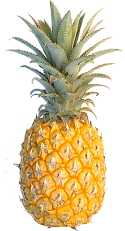
|
Annona cherimola
(Cherimola, Custard apple) Family:
Annonaceae The
Cherimola is a small tree with scaly-looking fruits that are about 10-12 cm
in diameter. It is native to the subtropical highlands of Peru and
Ecuador and is widely cultivated in Central America as well as subtropical
and tropical regions elsewhere. The flesh of the fruit is eaten raw or used
ice cream, milkshakes, jams, jellies and yoghurt. As the fruits do not last
long once picked, they are mainly sold on local markets. Although Cherimola
has been grown in southern Africa, it is rarely encountered in this region. |
|
Annona muricata
(Soursop, Guanábana)
Family:
Annonaceae The Soursop is a tree of up to 8 m high
bearing large thorny-surfaced 'custard apple' fruit, weighing up to 3 kg
each. The flesh in these fruits can be eaten raw, but more commonly is used
in fruit juices and softdrinks. It is also used in ice creams, sorbets and
jellies. Soursop is native to the tropical lowlands of Central America
and is now cultivated in many tropical and subtropical regions. It is rarely
encountered as a cultivated tree in southern Africa. |
|
|
Actinidia deliciosa (Kiwifruit)
Family: Actinidiaceae
Kiwifruit only came under cultivation in the 20th Century. It is native to China but New Zealand is the country that pioneered its cultivation.
The fruit contains high Vitamin C levels, evidently exceeding those of any
citrus fruit. It also contains a proteolytic enzyme that has meat tenderizer
type properties. Fruit can survive for long periods after picking, which
makes them ideal for the export market. A number of additional species of
Actinidia
are coming on to the market (see under
Actinidia).
|
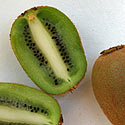 |
Carica papaya
(Pawpaw, Papaya) Family:
Caricaceae The Pawpaw originates from Mexico and Central
America and is now cultivated widely in tropical and subtropical
regions of the world. It is eaten raw as a fruit and contains high
levels of Vitamins A and C and a phytochemical called beta-cryptoxanthin
that promotes health. It also contains papain, which is an
antibacterial protease enzyme that has meat tenderising properties and is
used for clarifying beer. |

|
|
Cocos nucifera (Coconut)
Family: Arecaceae Coconut
Palms are native to the Indo-Pacific Ocean region and grow at the top of
beaches, at the limit of wave action. They are now grown in large
plantations and are used for producing many products, such as coconut oil
(from the white coconut endosperm), wine (toddy) and spirit (arrack). The
white endosperm of the coconut is used in cooking and confectionery.
|
|
Litchi chinensis (Litchi,
Lychee) Family:
Sapindaceae Indigenous from China to Cambodia. |
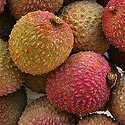 |
|
Mangifera indica
(Mango)
Family: Anacardiaceae
The Mango is native to Burma and NE India and its cultivation
extends back to about 2000 BC.
|
|
|
Musa acuminata (Banana)
Family: Musaceae
All edible bananas orginate in whole or in part from Musa acuminata
which is native to the Malay Peninsula and adjacent regions. In
prehistoric times, people selected plants with seedless fruits and since
then they have been propagated vegetatively from suckers. Although there
are huge commercial operations exporting bananas from tropical regions
to rich countries in temperate regions, the majority of bananas are
grown by small farmers in tropical countries for local consumption.
|
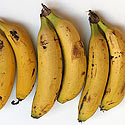 |
|
Passiflora
edulis (Purple granadilla, Passion fruit)
Family: Passifloraceae |
|
|
Phoenix dactylifera (Date)
Family: Arecaceae
|
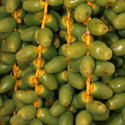 |
|
Psidium guajava (Guava)
Family: Myrtaceae |
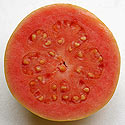
|
Tropical fruit rarely eaten in southern Africa include:
Averrhoa carambola
(Starfruit, Carambola);
Casimiroa edulis (White sapote, Mexican apple).
Deciduous fruits
|
Malus domestica
(Apple)
Family: Rosaceae
Wild apples were eaten by people from the earliest
of times. The domestic apples we eat nowadays are a hybrid mixture of 4
different wild species from the cool temperate regions of Europe, the Near
East and central Asia. New apple varieties are propagated by grafting,
rather than from seed or from cuttings. |
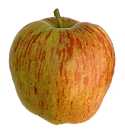
|
Punica granatum (Pomegranate)
Indigenous from Turkey to Central Asia. Cultivated for its edible fruit.
Cultivated plants in southern Africa are mainly in gardens but it is also
grown commercially on a small scale. |
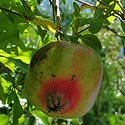 |
|
Prunus persica (Peach & Nectarine)
Family: Rosaceae
|
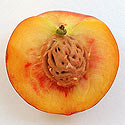 |
|
Prunus armeniaca (Apricot)
Family: Rosaceae
|
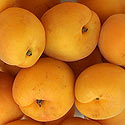 |
|
Prunus domestica (Plum)
Family: Rosaceae
|
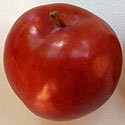 |
|
Prunus avium (Cherry)
Family: Rosaceae
|
|
|
Pyrus communis (Pear)
Family: Rosaceae
|
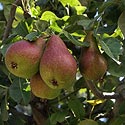
|
|
Vitis vinifera (Grape)
Family: Vitaceae
|
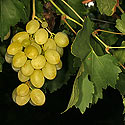 |
Other fruit
Wild indigenous fruits collected in southern Africa
Publications
-
van Wyk, B.-E. & Gericke, N. 2000. People's Plants. A
Guide to Useful Plants of Southern Africa. Briza Publications,
Pretoria.
Links
Text by Hamish G. Robertson
|
